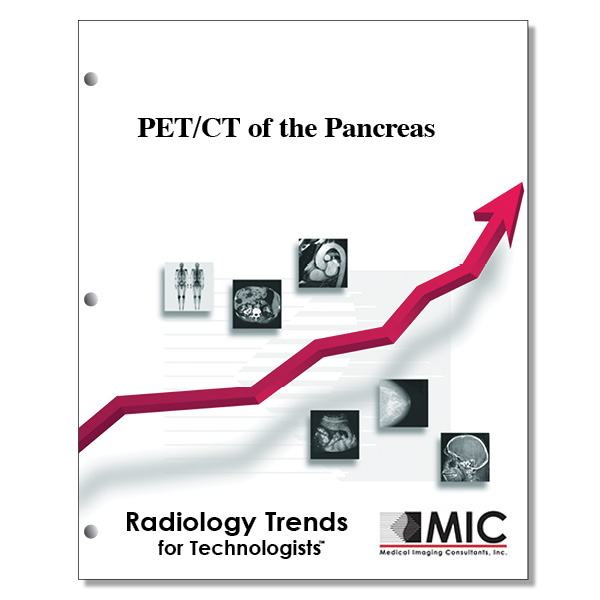

PET/CT of the Pancreas
A review of PET/CT for depicting pancreatic tumors and distant metastases, performing preoperative staging, and monitoring response to treatment.
Course ID: Q00345 Category: Radiology Trends for Technologists Modalities: CT, Nuclear Medicine, PET, Radiation Therapy4.0 |
Satisfaction Guarantee |
$39.00
- Targeted CE
- Outline
- Objectives
Targeted CE per ARRT’s Discipline, Category, and Subcategory classification:
[Note: Discipline-specific Targeted CE credits may be less than the total Category A credits approved for this course.]
Computed Tomography: 1.25
Procedures: 1.25
Abdomen and Pelvis: 1.25
Magnetic Resonance Imaging: 1.25
Procedures: 1.25
Body: 1.25
Nuclear Medicine Technology: 3.25
Image Production: 0.25
Instrumentation: 0.25
Procedures: 3.00
Endocrine and Oncology Procedures: 3.00
Registered Radiologist Assistant: 3.00
Procedures: 3.00
Abdominal Section: 3.00
Sonography: 1.25
Procedures: 1.25
Abdomen: 1.25
Radiation Therapy: 3.00
Patient Care: 1.50
Patient and Medical Record Management: 1.50
Procedures: 1.50
Treatment Sites and Tumors: 1.50
Outline
- Introduction
- Multidetector CT
- Positron Emission Tomography
- PET/CT: Technical Considerations
- Role of PET/CT in Pancreatic Imaging
- Diagnosing Pancreatic Cancer When Other Imaging Findings Are Equivocal
- Preoperative Staging
- Characterization of Lymph Nodes
- Depiction of Liver Metastases
- Depiction of Peritoneal Metastases
- Depiction of Distant Metastases
- Depiction of Tumor Recurrence and Monitoring Response to Therapy
- Other Pancreatic Neoplasms
- Pancreatic Endocrine Neoplasms
- Pancreatic Lymphoma
- Metastases
- Cystic Neoplasms
- Pancreatitis
- Recent Developments in PET
- Novel Radiotracers
- PET/MR Imaging
- Summary
Objectives
Upon completion of this course, students will:
- be familiar with PET/CT imaging of the pancreas
- be familiar with the various acronyms for pancreatic diseases
- know the various uses for PET/CT in the assessment of pancreatic adenocarcinomas
- know the goal of pancreatic cancer imaging
- understand why multi-detector CT is the mainstay for imaging of suspected pancreatic cancer
- be familiar with the limitations of multi-detector CT imaging of suspected pancreatic cancer
- understand the categorization of patient examination results
- understand the sensitivity component of examination results
- understand the terms “positive predictive value” and “negative predictive value”
- know the end goal of any diagnostic examination
- be familiar with some of the characteristics of malignant lesions
- know the comparison points between FDG PET and contrast-enhanced CT for distinguishing between MFP and pancreatic cancer
- understand how elevated glucose levels affect FDG PET imaging of pancreatic malignancy
- know some of the drawbacks of PET imaging
- know the standard blood glucose level restrictions for FDG injection
- understand the effects of circulating insulin levels on FDG uptake
- know the necessity for utilizing a neutral oral contrast agent over a positive one in PET/CT
- be familiar with the weight-based PET imaging time per bed position scanning settings
- know the basis for the amount of CT IV contrast material administration
- be familiar with the typical patient preparation steps for FDG PET imaging
- know the disease which is the fourth leading cause of cancer-related death in the US
- know the 5-year survival rate after a diagnosis of pancreatic cancer
- identify the only curative treatment for locally resectable and non-metastatic pancreatic cancer
- know the items to identify in order to determine the resectability of a pancreatic adenocarcinoma
- identify a possible cause of pancreatic cancer biopsy sampling error that is inherent to most pancreatic cancers and recurrent tumors
- know why about 10% of pancreatic adenocarcinomas and metastases are not depicted at contrast-enhanced CT, even when larger than 2cm
- understand how the SUVmax of a malignant lesion compares to normal liver tissue
- understand the reasoning for setting a cancer diagnosis SUV threshold of 4.0 to distinguish between MFP and pancreatic adenocarcinoma
- know the components of the most commonly used SUV calculation
- identify what is usually indicative of a poor prognosis for pancreatic cancer
- be familiar with the term “in situ” in TNM tumor staging
- understand the pancreatic cancer TNM staging system for translating categories into stages
- be familiar with the causes of reactive lymph node enlargement around the pancreas
- be familiar with the reasons for the poor performance of FDG PET for lymph node staging
- identify the imaging modality that is superior for depiction of distant metastases
- identify the main objective of pancreatic cancer staging after initial diagnosis and confirmation of local resectability
- know what is indicative of pancreatic adenocarcinoma recurrence three months after surgery
- identify the recommended minimum wait time before performing follow-up FDG PET after surgery
- know how pancreatic endocrine neoplasms are named
- be familiar with what characterizes most pancreatic neuroendocrine tumors
- know what critical piece of information is necessary to diagnose pancreatic lymphoma
- be familiar with primary malignancies that most commonly metastasize to the pancreas
- identify the SUV cutoff that can be utilized to distinguish between benign and malignant IPMNs
- be familiar with the characterizations of Type I AIP
- know some of the characteristics and advantages of 18F FLT
